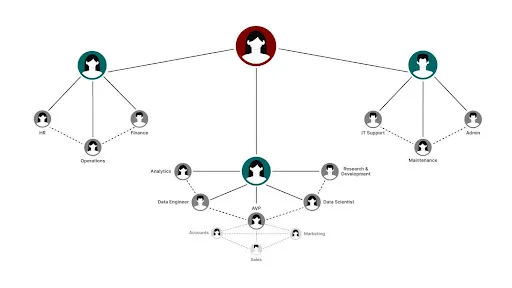Rethinking Organizations
- By Ashish Sawant & Todd Wandtke
- Read Time: 3 Min

The U.S. Navy Seals are an elite team of highly professional, agile, and skilled soldiers deployed to some of the most important military missions. Have you ever stopped to wonder what makes them so effective?
Of course, the mental and physical skills of each soldier and thousands of hours of repetitive training that they receive play a role, but also the way the Seals are structured reveals an important aspect of their effectiveness and efficiency.
Navy Seals operate within two structures, a hierarchical command-and-control structure, and an independent web-like structure comprised of small teams at the operation level.
The commanders give out the missions, officers relay them to the troops, and then the Seals carry out their objectives with little micromanagement.
These two structures – a hierarchical tree-like chain of command and a web-like organization on the ground — have combined to give the Seals a reputation of excellence and efficiency.
Organizations can learn a lot from these two types of structures.
A tree structure offers stability. It enforces discipline and ensures orders are conveyed directly and efficiently. However, this structure can only facilitate communication one way at a time: either from commander to soldier or the other way around. It can also slow down the process of communication since any message that must be relayed to the last in the chain of command must pass through every level in the chain.
The web structure, on the other hand, comprises interconnected nodes – every soldier has direct contact with every team member on the ground. Teams have mutual trust and purpose, through shared experiences. As a result, they all understand what the desired outcome is, and what each person needs to do to achieve it quickly. Such teams are highly adaptable and can change course quickly depending on the situation. Webs offer agility and unity, which projects effectiveness and precision.
By combining the tree and web structures within each operation, the Navy Seals have become a well-oiled machine that is the envy of the world.

How Do These Structures Operate?
Traditional organizations have often resembled hierarchical trees. The control of information flow rests with leadership, and the information flows in a unidirectional manner from leadership to employees. Leadership receives feedback from employees in a similar unidirectional manner. Team leads often micromanage tasks, and employees are directed on what to do.
The tree structure was suitable for periods when operational speed was slower, and larger workforces were necessary for scaling. Many organizations care more about efficiency and structure themselves in a way that everyone follows one person’s commands. The problem with this is that one single person alone can’t grasp the complexity that comes with modern problems.
A web structure, on the other hand, can help organizations share information more rapidly among all stakeholders within the organization, from the CEO to the contributors, facilitating adaptive problem-solving and fostering a culture of innovation. By adopting a web-like structure, organizations can enhance their problem-solving capabilities, increase speed, and improve overall resilience. This model empowers employees to contribute to the organization’s success, fostering a sense of ownership and engagement.
Webs present challenges when applied to larger groups. Managing and executing tasks becomes more complex due to the increased number of inputs, potentially slowing down processes. Additionally, web structures demand highly skilled individuals with complementary and equally valued expertise.

Webs Within Trees
Contemporary business challenges necessitate agility and collaboration while remaining aligned with a broader organizational vision. The rise of giants like Amazon, which operates on a both a structured level with its platform services and as an interconnected network of sellers on the platform demonstrates the need for such hybrid structures.
A purely web-based structure may lack the necessary control and accountability in certain areas. A hybrid approach, combining elements of both hierarchical and network structures, may offer the most effective solution. Teams are great at creating cohesiveness, but they also exclude those outside of the team. Smaller teams must make sure they work together with the other teams as a larger team. Multiple teams can share the same overall processes and purpose. Businesses must ensure there is a shared understanding of the context of their work, so they can work towards the organizational vision, and not just that of the team.
The digital age demands a rethinking of organizational structures. While the hierarchical model serves its purpose, the increasing complexity of the business environment necessitates a more fluid and interconnected approach. Embracing a hybrid structure that is robust and agile in adaptation can help organizations position themselves for long-term success as problem solvers.



